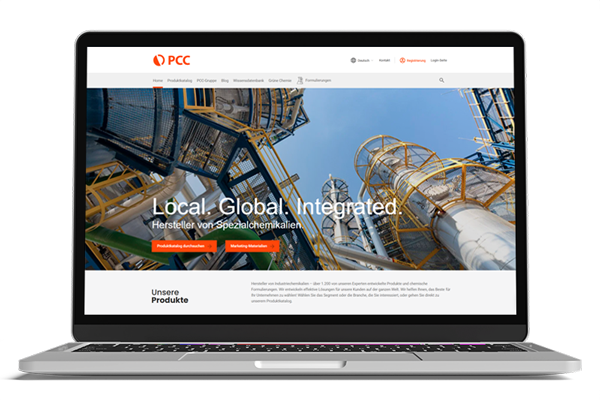Surfactants & Derivatives
Multiple effects for foaming, wetting, emulsifying and cleaning
In Piedmont, in the US state of South Carolina, PCC Chemax, Inc. also develops specialty surfactants for industrial applications, which it markets on a global scale.
In the Surfactants segment, we also manage the downstream activities of PCC Consumer Products S.A. in the area of consumer goods, the important basic components of which are surfactants. Our consumer goods production includes household and industrial cleaning products as well as detergents and personal care products. We distribute these both under our own brand names and as a private label manufacturer.
What are surfactants?
One traditional surfactant known throughout the ages is soap. However, modern surfactants serve a far richer range of applications. They constitute indispensible components of a wide spectrum of consumer goods – from laundry care and dishwashing detergents to shampoos, toothpastes and cosmetic products. Surfactants are also used in the food and pharmaceutical industries. The Surfactants segment of PCC comprises the business units Anionic Surfactants, Non-ionic Surfactants, and Amphoteric Surfactants (Betaines).
Modes of action
Foaming
Foam (aka suds, lather) occurs where air is entrapped in a surfactant solution – for example as the result of shaking. The surfactant molecules arrange themselves at the liquid/air interface, thus creating the envelopes we know as soap bubbles. During cleaning processes, this formation of foam is often desirable because it ensures, for example, that water is able to penetrate the structure of a fabric more effectively. Heavy foaming can, however, also be disruptive – in which case defoamers are used, which are also based on surfactants.
Wetting
Used as wetting agents, surfactants reduce the interfacial tension between a solid and a liquid. That enables water, for example, to become more evenly distributed over a hard surface rather than coagulating into droplets. The solid is then said to have been wetted.
Emulsifying
Surfactants can make generally mutually repellent liquids, such as water and oil, miscible in the form of an emulsion. Because of the “amphiphilic” – that is to say simultaneously “water-attracting” and “water-repelling” – nature of surfactants, they are able to penetrate the oil with their fat-dissolving portion. The oil droplets caused e.g. by stirring, remain finely distributed through the action of the hydrophilic component of the molecule.
Cleaning
A further action mode of surfactants lies in their ability to promote the detachment of small solid particles from solid surfaces, as in the removal of dirt from textiles. Surfactants support the formation and retention of a suspension by becoming deposited around the solid particles, thus inhibiting their agglomeration and preventing them from sinking. Further deposition on solid surfaces which are covered by a surfactant layer is also avoided.
Application spectrum
Cleaning detergents and personal care products
Anionic, non-ionic and amphoteric surfactants are basic components of laundry detergents, household cleaners and personal care products such as shampoos and shower gels. They promote skin compatibility, can produce a pearlescent effect and beneficially modify the flow properties of liquids.
Textile manufacturing
Surfactant-based foaming and wetting agents, emulsifiers, defoamers and dispersants are used in the following processes: cleaning, spinning, bleaching, scouring, dyeing and fibre maceration.
Construction industry
Surfactants are used here as foaming agents in fibreboard and plasterboard panel production, as additives in the manufacture of chipboard, and as superplasticizers for fresh concrete mixtures.
PCC Consumer Products
Application range of PCC consumer goods
Household and industrial cleaners, detergents and personal care products
Cleaning products for floors, sanitary facilities and glass surfaces, for hand hygiene, as well as universal cleaners for the following sectors:
- Authorities
- Cleaning companies
- Hotels and restaurants
- Food industry
- Agriculture
Private labels
As a leading private label manufacturer, we focus on manufacturing products under our own brands for leading discounters and retail chains, primarily in Poland. We have been one of the most important private label providers there for many years – as a specialist in the production of all liquid agents in the field of industrial, household chemicals and cosmetics.
Our products
For more information on our products, please visit PCC’s extensive product portal on www.products.pcc.eu containing more than 1,300 products and chemical formulations for numerous industrial applications.

Our sites / Contact details
Surfactants division
ul. Sienkiewicza 4
56-120 Brzeg Dolny
Production site: Piedmont, South Carolina (USA)
30 Old Augusta Rd.
29673 Piedmont, SC
ul. Sienkiewicza 4
56-120 Brzeg Dolny
Produktion site: Brzeg Dolny (PL)
ul. Sienkiewicza 4
56-120 Brzeg Dolny
Production site: Grodno (Belarus)
Skidelskoye shosse 20A/2
230003 Grodno
Telefon 2: +375 (152) 68 53 31
Fax: +375 (152) 96 99 89
E-Mail: pccnavigator@pcc.eu
Production site: Moscow (RU)
ul. Spiridonovka 30/1
123001 Moskau
Fax: +7 495 695 58 00
